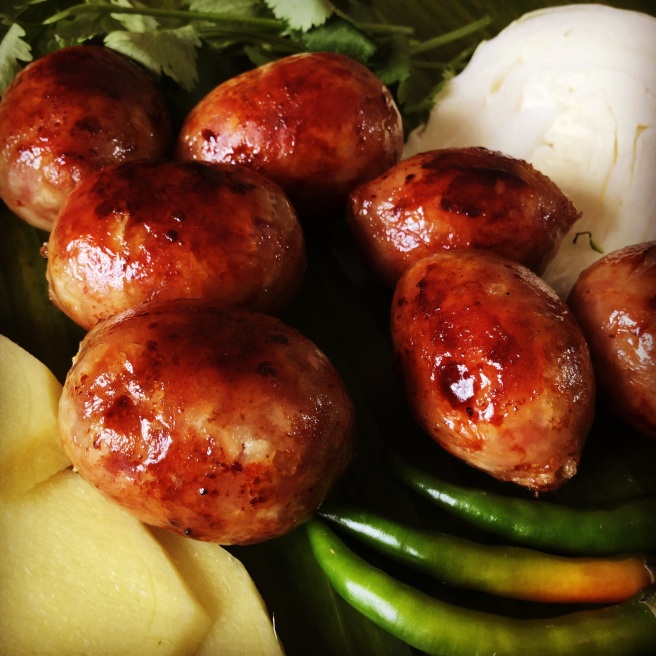 As I said in my previous beer food post, sai krok are my absolute favourite beer food. Garlicky, salty, slightly sour and a little fatty, they come accompanied by raw chillies, slices of ginger and white cabbage which cuts through the richness and makes for an explosion of flavour. I simply love ’em!
As I said in my previous beer food post, sai krok are my absolute favourite beer food. Garlicky, salty, slightly sour and a little fatty, they come accompanied by raw chillies, slices of ginger and white cabbage which cuts through the richness and makes for an explosion of flavour. I simply love ’em!
Whilst on an extended stay in Thailand a couple of years back, my wife, Kate and I spent several months in the seaside town of Hua Hin. Early evening would often find us sat at a tiny mobile bar in the night market swigging Singhas and watching the world go by. If we were lucky one of the local sai krok carts would also go by and we would find ourselves stuffing our faces with these little wonders along with chillies and pickled ginger. They were insanely good and I didn’t even realise that they were fermented, I just knew that they were delicious. Since then I have been hooked on various Isan fermented goodies.
Fermentation sounds a bit scary when it comes to meat but if done correctly is perfectly safe. Lots of the salami and chorizo type meats produced in Europe are fermented and we eat those raw. The Thais too eat raw fermented pork in the form of naem, but these particular fermented sausages are cooked by grilling over wood or by frying.
Now I’m no scientist, but the basics of fermentation the Thai way are to combine meat (or fish) with rice, garlic and salt and keep it at tropical room temperature around 30°C. The salt prevents the meat from spoiling allowing the lactic acid bacteria to feed on the rice, fermenting the meat. The fermentation process enables the lactic acid bacteria to multiply, which gives the sausage its sour taste. It takes one or two days for the process to work depending on the temperature.
A word of caution, do not be tempted to change the recipe proportions. Altering the relative amounts of pork, rice or salt could inhibit fermentation and allow the meat to spoil.
Enough science time to cook!
Ingredients
- 25 grams of garlic
- 1 teaspoon of salt
- 230 grams of cooked jasmine rice (100g of raw rice should make this amount)
- 500 grams of pork shoulder*
- natural sausage casings*
- white vinegar
- salt
Method
Follow the instructions from the supplier of the sausage casing to prepare them for use. In my case the casings were salted so I had to soak them in water overnight.
Wash the casings in a mixture of salt and vinegar, then run plenty of water though the casings to further wash them inside and to check that they are not split, you’ll see water leaking out if they are split.
Take a metre or two of the casings and thread them onto a wide funnel and tie a knot in the end. I chopped my funnel down slightly as the end originally narrowed too much.
Cook the rice, allow to cool and rinse in lots of water to remove excess starch then drain well.
Pound the teaspoon of salt with the garlic into a paste.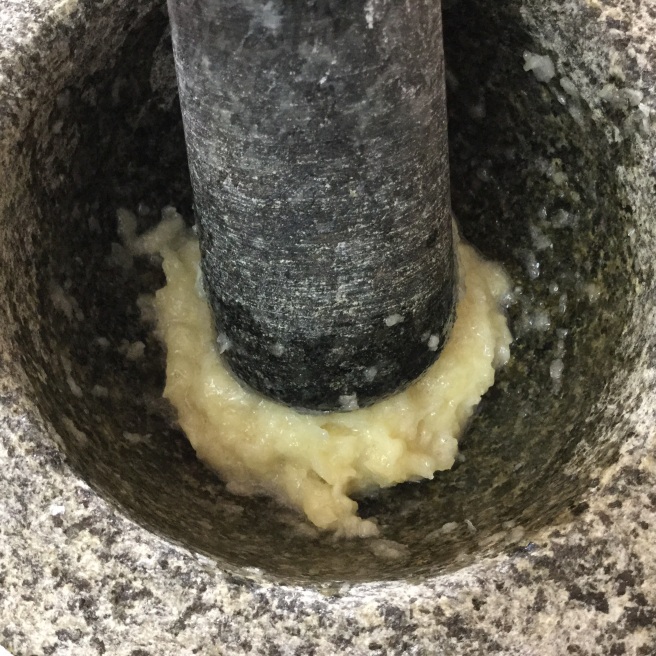
Add the rice and pound this into a rough paste, do not over work the rice as it can become tough and solid. I had to switch to a bigger pestle and mortar to do this as you can see. Combine the pork with the rice mixture and mix well with your hands.
Combine the pork with the rice mixture and mix well with your hands.
Take a spoonful of mixture and fry until cooked, then check for seasoning. 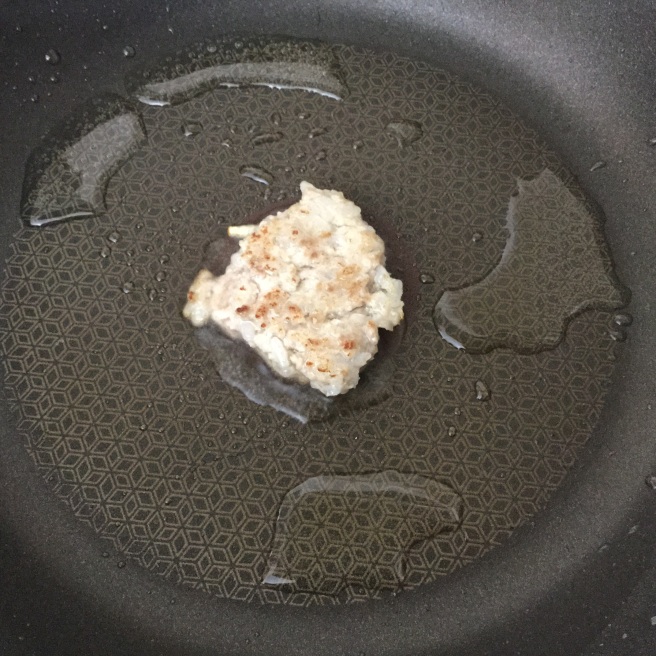 It should be slightly under salted as moisture will be lost during fermentation thus increasing the saltiness. Add more salt if required.
It should be slightly under salted as moisture will be lost during fermentation thus increasing the saltiness. Add more salt if required.
To make the sausages, force the pork mixture through the funnel whilst holding the casings, allowing some casing to be released a bit at a time. This is a bit fiddly but you will get the hang of it after a minute or two. You can use a pestle to force the meat through if you prefer.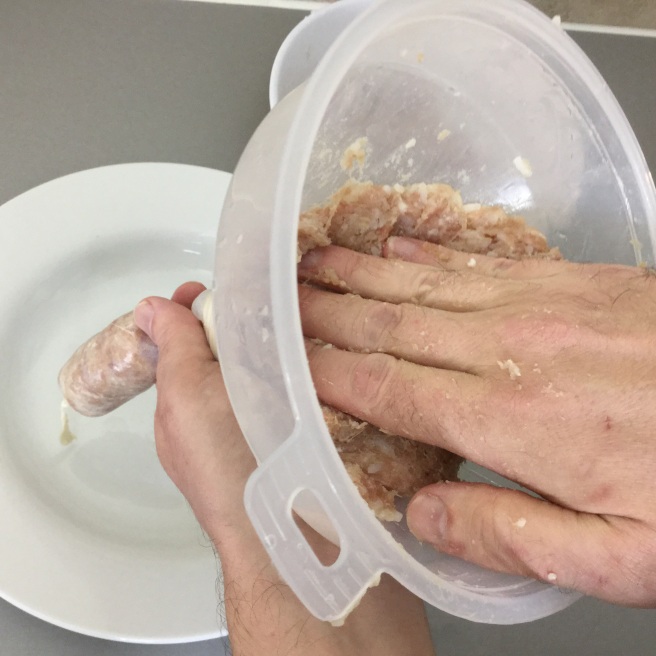
Once all the meat is in the casing remove it from the funnel.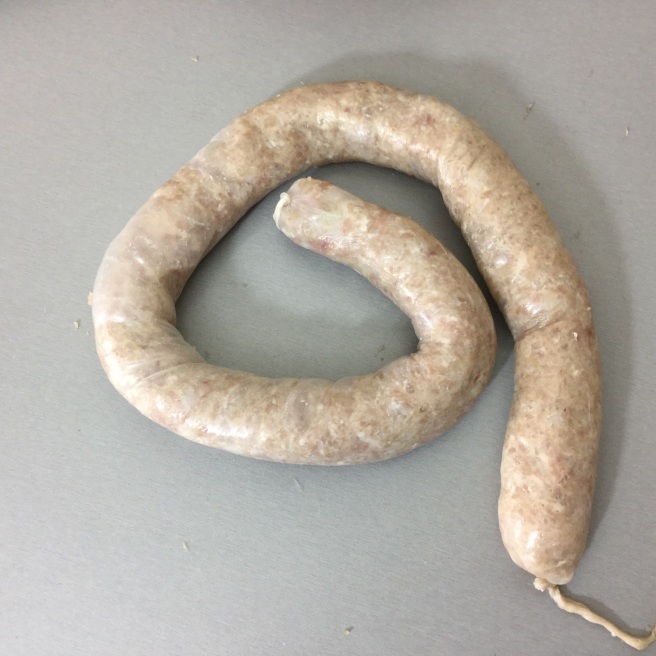
Use your hands to evenly distribute the pork so that you have a sausage approximately 3/4 of an inch in diameter knotted at one end and open at the other. Mine is actually a little bigger than 3/4 of an inch but that was not my intention. My casings also split mid way through making them so I ended up with two long sausages at this point.
To make the sausage links start at the knotted end and about an inch in, squeeze and then twist the long part of the sausage a couple of turns. Then repeat an inch from the first twist keeping the first link still.  I’ve found that the best way to make the links is to keep the formed bits still and twist the large bit. It is fiddly and occasionally a link may untwist but if it does just go back and twist it back but turn everything from that point to the end. If anyone has an easier way please let me know. When you have done the whole sausage tie up the end with string, tie another piece of string to the knotted end and then join the two pieces of string. You can now hang the sausages and the links should not untwist.
I’ve found that the best way to make the links is to keep the formed bits still and twist the large bit. It is fiddly and occasionally a link may untwist but if it does just go back and twist it back but turn everything from that point to the end. If anyone has an easier way please let me know. When you have done the whole sausage tie up the end with string, tie another piece of string to the knotted end and then join the two pieces of string. You can now hang the sausages and the links should not untwist. If the weather is hot i.e. 25°C + you can hang them in a room for a day or two. If not then you’ll need to find somewhere warm to ferment them. Hang the sausages with a bowl underneath to catch any moisture that may drip out and use a thermometer to ensure that the temperature is correct 25°C to 30°C.
If the weather is hot i.e. 25°C + you can hang them in a room for a day or two. If not then you’ll need to find somewhere warm to ferment them. Hang the sausages with a bowl underneath to catch any moisture that may drip out and use a thermometer to ensure that the temperature is correct 25°C to 30°C.
I put a small 500 watt radiator in the cupboard where my water tank is and managed to bring the heat up to around 28°C with the addition of foil above the radiator and sausages to lessen heat loss. 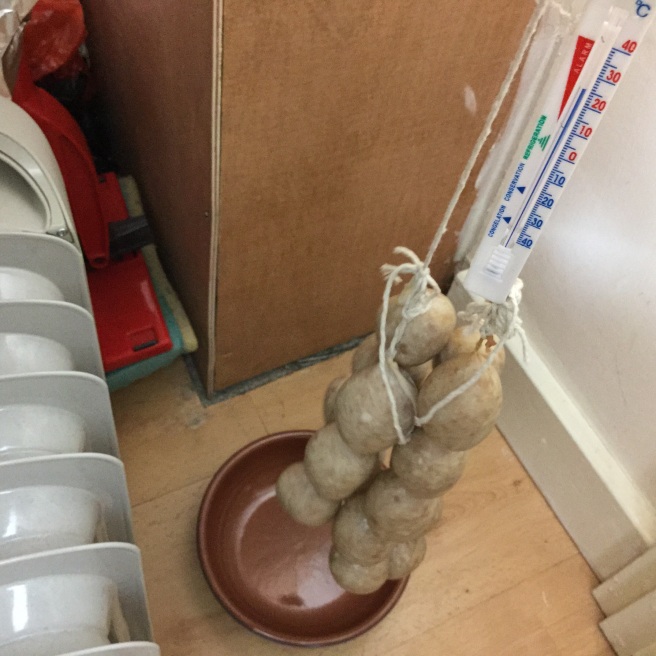
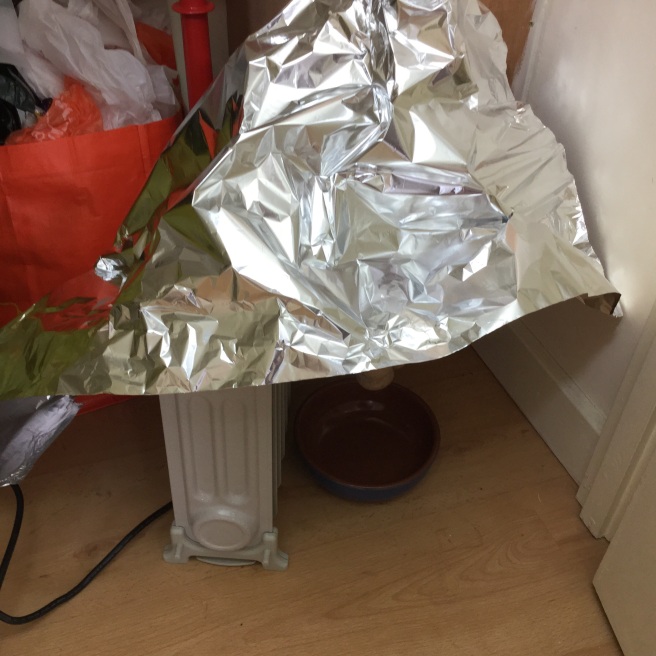 If using a heater try not to have the sausages too close. Fermentation should be complete within 24 to 48 hours. To check your sausages just cook one up. It should taste sour and clean. If it is not sour enough allow them more time to ferment. If they taste off in any way discard them all.
If using a heater try not to have the sausages too close. Fermentation should be complete within 24 to 48 hours. To check your sausages just cook one up. It should taste sour and clean. If it is not sour enough allow them more time to ferment. If they taste off in any way discard them all.
Once fermented the sausages can be stored in a sealed container in the fridge for a few days. The fridge temperature will prevent further fermentation.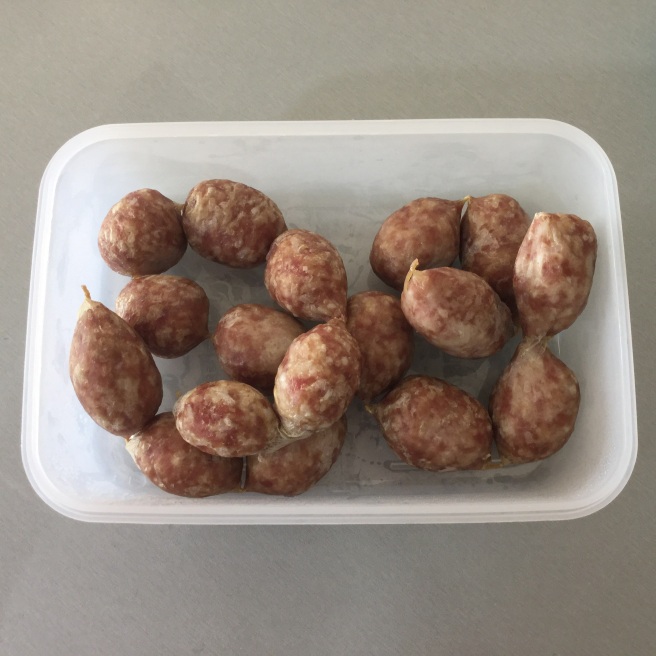 To cook, separate the sausages and prick each one several times to prevent bursting, then either grill on a barbecue or fry in a pan with a little oil for a few minutes.
To cook, separate the sausages and prick each one several times to prevent bursting, then either grill on a barbecue or fry in a pan with a little oil for a few minutes.
 Allow to cool slightly then serve with raw chilli, slices of ginger and a little white cabbage to wrap them in. Oh yes and you must, must serve them with an ice cold beer.
Allow to cool slightly then serve with raw chilli, slices of ginger and a little white cabbage to wrap them in. Oh yes and you must, must serve them with an ice cold beer.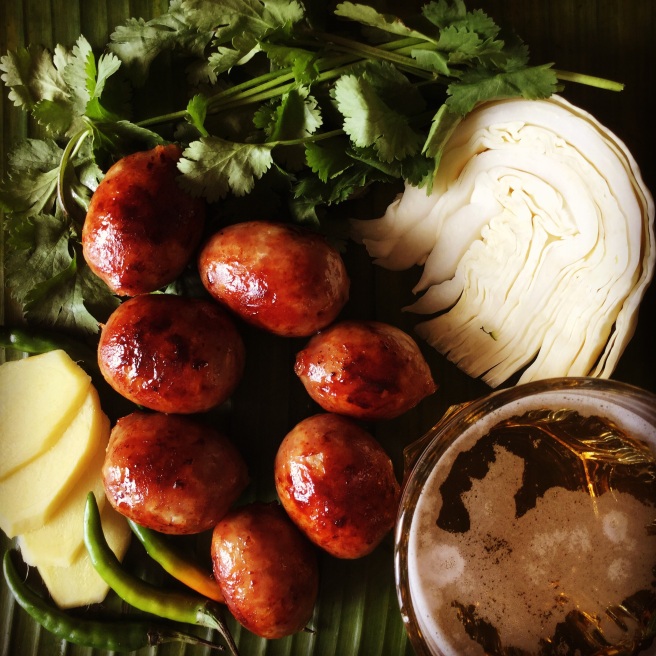
*A note in ingredients
Try and get your butcher to mince the meat for you on a medium grate.
Sausage casings are available online.
For those of you local to me Hofmann’s butchers at the top of Westgate in Wakefield has all free range pork and they are happy to mince cuts to order.


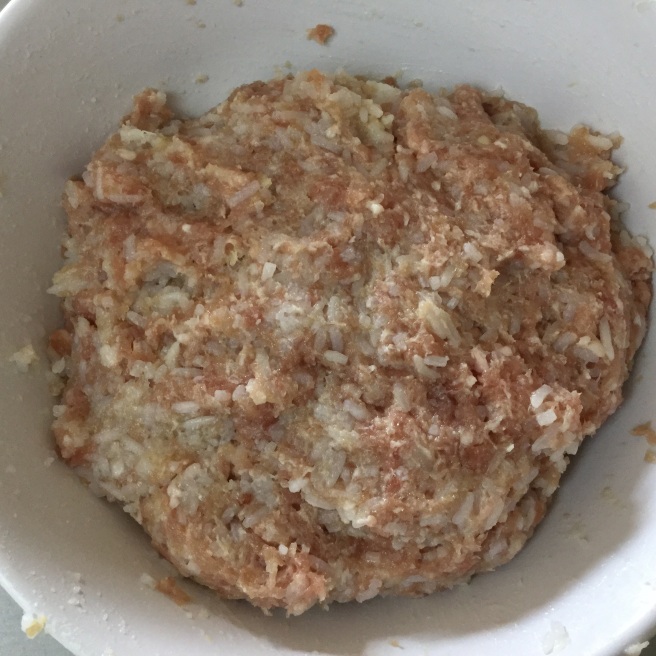
Great article. Thanks a lot for sharing! I will be back soon to my country after spending 3 years in Thailand and I was wondering how to keep eating Isaan sausage while home. I will definitely try your way, thanks!
LikeLike
Thanks for your kind words. I can highly recommend shesimmers.com blog for recipes and also the book Thai Street Food by David Thompson which is what my sai krok recipe was based on. Also excellent books are Pok Pok and The Dinking Food of Thailand by Andy Ricker. Have fun!
LikeLike
I love fermented sausages, deliciously sweet and tart. Thanks for the recipe.
LikeLike
Thank you so much for your post. Well detailed. Kudos for showing me how to put it near the radiator and all. I have a backyard but it wasn’t possible to dry the meat so I have been deprived (LOL) of food like this. Sai korks here in the US aren’t the same as how I had them back in Bangkok. I’ll definitely give it a try. Thank you again.
LikeLike